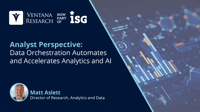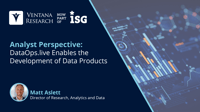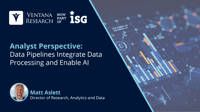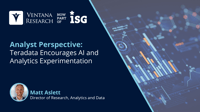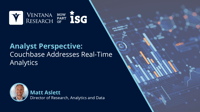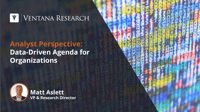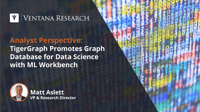I am happy to share insights gleaned from our latest Buyers Guide, an assessment of how well software providers’ offerings meet buyers’ requirements. The Data Platforms Ventana Research Buyers Guide is the distillation of a year of market and product research by ISG and Ventana Research.
Read More
Topics:
data platforms,
Analytics & Data,
analytic data platforms,
Operational Data Platforms
The emergence of generative artificial intelligence (GenAI) has significant implications at all levels of the technology stack, not least analytics and data products, which serve to support the development, training and deployment of GenAI models, and also stand to benefit from the advances in automation enabled by GenAI. The intersection of analytics and data and GenAI was a significant focus of the recent Google Cloud Next ’24 event. My colleague David Menninger has already outlined the key...
Read More
Topics:
Analytics,
natural language processing,
AI & Machine Learning,
data platforms,
Analytics & Data,
Generative AI
I previously wrote about the potential for rapid adoption of the data lakehouse concept as enterprises combined the benefits of data lakes based on low-cost cloud object storage with the structured data processing functionality normally associated with data warehousing. By layering support for table formats, metadata management and transactional updates and deletes as well as query engine and data orchestration functionality on top of low-cost storage of both structured and unstructured data,...
Read More
Topics:
Analytics,
data platforms,
Analytics & Data
I recently wrote about the development, testing and deployment of data pipelines as a fundamental accelerator of data-driven strategies. As I explained in the 2023 Data Orchestration Buyers Guide, today’s analytics environments require agile data pipelines that can traverse multiple data-processing locations and evolve with business needs.
Read More
Topics:
Analytics,
data operations,
AI & Machine Learning,
data platforms,
Analytics & Data,
Generative AI,
Data Intelligence
I wrote recently about the role that data intelligence has in enabling enterprises to facilitate data democratization and the delivery of data as a product. Data intelligence provides a holistic view of how, when, and why data is produced and consumed across an enterprise, and by whom. This information can be used by data teams toensure business users and data analysts are provided with self-service access to data that is pertinent to their roles and requirements. Delivering data as a product...
Read More
Topics:
Analytics,
Data Ops,
data operations,
AI & Machine Learning,
data platforms,
Analytics & Data,
GenAI,
Data Intelligence
The development, testing and deployment of data pipelines is a fundamental accelerator of data-driven strategies, enabling enterprises to extract data from the operational applications and data platforms designed to run the business and load, integrate and transform it into the analytic data platforms and tools used to analyze the business. As I explained in our recent Data Pipelines Buyers Guide, data pipelines are essential to generating intelligence from data. Healthy data pipelines are...
Read More
Topics:
Analytics,
AI,
data operations,
AI & Machine Learning,
data platforms,
Analytics & Data,
Data Intelligence
Cloud computing has had an enormous impact on the analytics and data industry in recent decades, with the on-demand provisioning of computational resources providing new opportunities for enterprises to lower costs and increase efficiency. Two-thirds of participants in Ventana Research’s Data Lakes Dynamic Insightsresearch are using a cloud-based environment as the primary data platform for analytics.
Read More
Topics:
Analytics,
AI,
AI & Machine Learning,
data platforms,
Analytics & Data,
Generative AI,
Data Intelligence
I have previously written about the impact of intelligent operational applications on the requirements for data platforms. Intelligent applications are used to run the business but also deliver personalization, recommendations and other features generated by machine learning and artificial intelligence. As such, they require a combination of operational and analytic processing functionality. The emergence of these intelligent applications does not eradicate the need for separate analysis of...
Read More
Topics:
Analytics,
Artificial intelligence,
AI & Machine Learning,
data platforms,
Analytics & Data,
Generative AI
When joining Ventana Research, I noted that the need to be more data-driven has become a mantra among large and small organizations alike. Data-driven organizations stand to gain competitive advantage, responding faster to worker and customer demands for more innovative, data-rich applications and personalized experiences. Being data-driven is clearly something to aspire to. However, it is also a somewhat vague concept without clear definition. We know data-driven organizations when we see them...
Read More
Topics:
embedded analytics,
Analytics,
Business Intelligence,
Data Governance,
Data Integration,
Data,
Digital Technology,
natural language processing,
data lakes,
data operations,
Streaming Analytics,
AI & Machine Learning,
digital business,
data platforms,
Analytics & Data,
Streaming Data & Events
I recently wrote about the growing range of use cases for which NoSQL databases can be considered, given increased breadth and depth of functionality available from providers of the various non-relational data platforms. As I noted, one category of NoSQL databases — graph databases — are inherently suitable for use cases that rely on relationships, such as social media, fraud detection and recommendation engines, since the graph data model represents the entities and values and also the...
Read More
Topics:
business intelligence,
Analytics,
Cloud Computing,
Data,
Digital Technology,
AI & Machine Learning,
data platforms,
Analytics & Data





